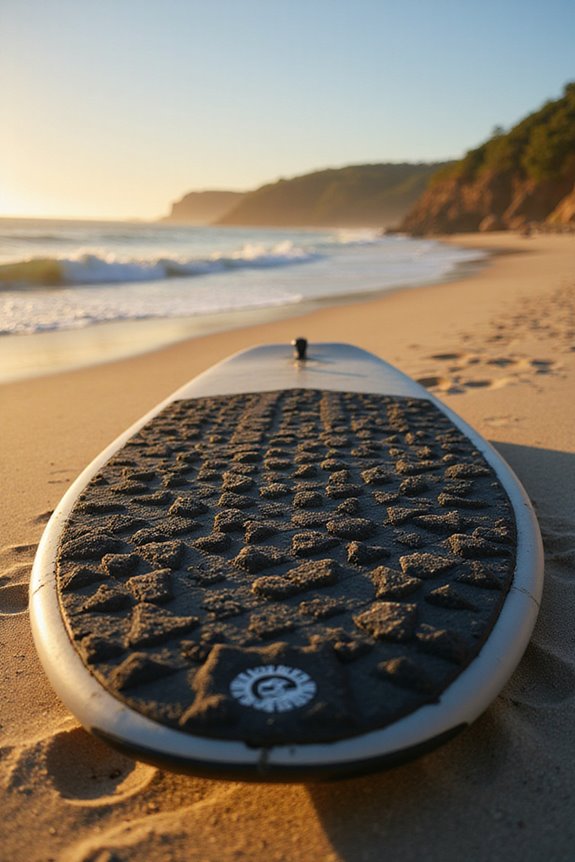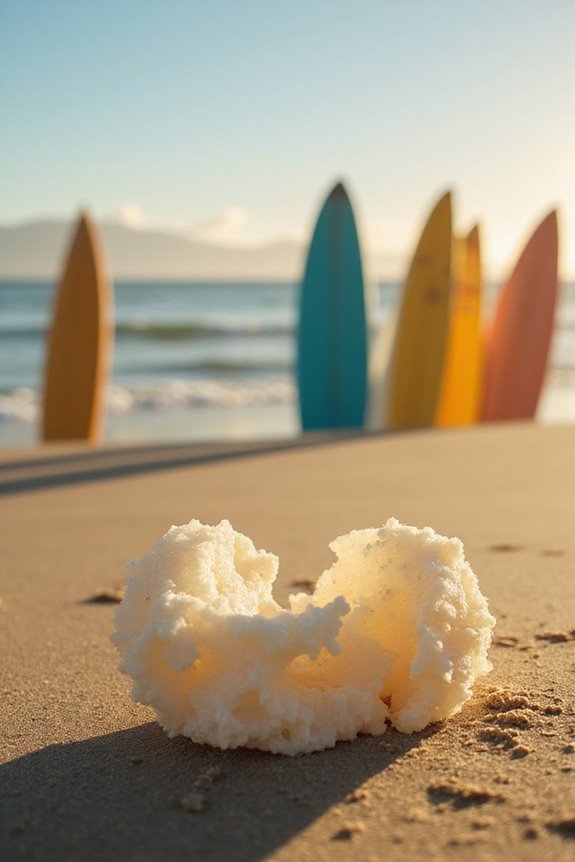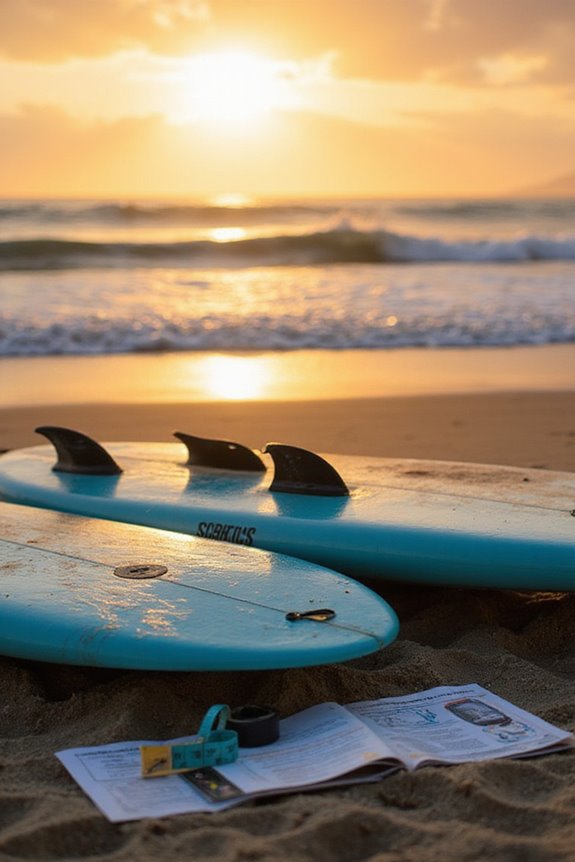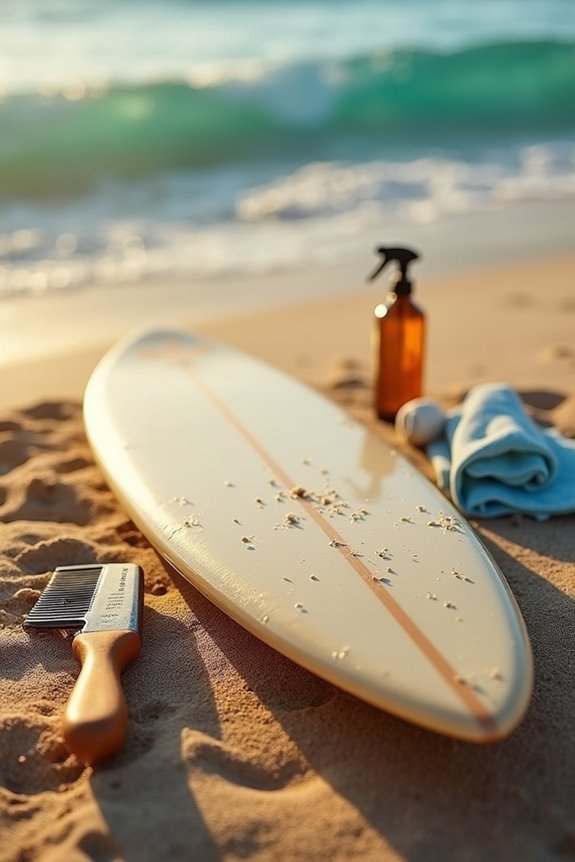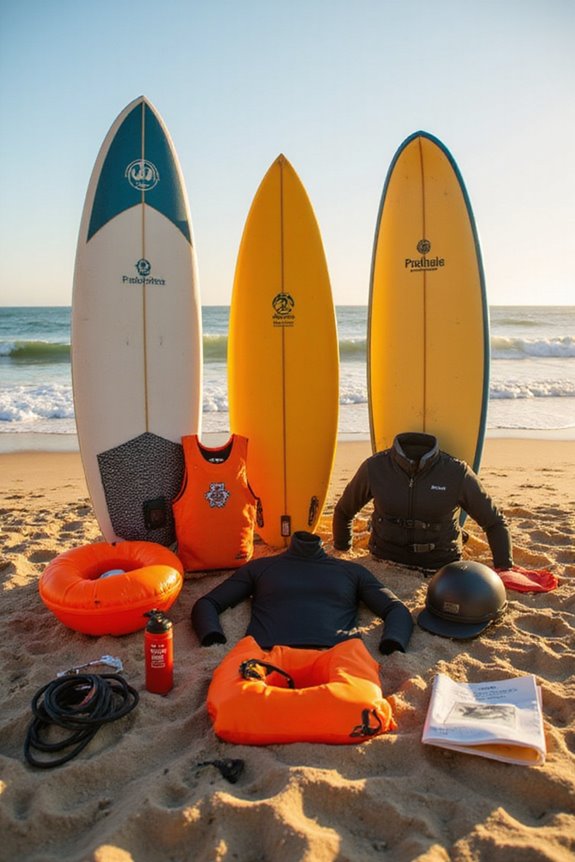A traction pad is an essential surfboard accessory that enhances grip and control while we ride. It’s typically made from materials like EVA foam or rubber, providing textured surfaces to prevent foot slippage. These pads often have features like arch support and kick tails for added stability. By using a traction pad, we can improve our performance, reduce injury risk, and enjoy a more confident surfing experience. There’s more to explore about its different types and installation tips.
Key Takeaways
- A traction pad is an essential surfboard component that provides grip to prevent foot slippage during maneuvers.
- Made from materials like EVA foam and rubber, traction pads enhance control and reduce injury risk.
- They come in various configurations, including single and multi-piece designs, to fit different board shapes.
- Key features like textured surfaces, arch support, and kick tails improve stability and performance while surfing.
- Regular maintenance, such as rinsing after use and inspecting for damage, ensures longevity and effectiveness of the traction pad.
Definition and Purpose of a Traction Pad
A traction pad, often referred to as a deck pad or tail pad, is an essential component of many surfboards. Made from materials like EVA foam, rubber, or silicone, these pads provide exceptional grip. They feature textured surfaces, often in diamond or hexagonal patterns, designed to minimize water absorption and enhance traction.
The primary purpose of a traction pad is to prevent foot slippage while surfing. By ensuring our feet stay securely positioned, these pads improve control during turns and high-speed maneuvers. This surfing innovation helps reduce injury risk, boosts confidence, and enables surfers to generate more power and speed. Ultimately, traction pads have become crucial tools for both recreational and professional surfers alike. Additionally, high-quality traction pads made from durable EVA foam are known for their lightweight and long-lasting performance, making them a popular choice among surfers.
Structure and Design Components
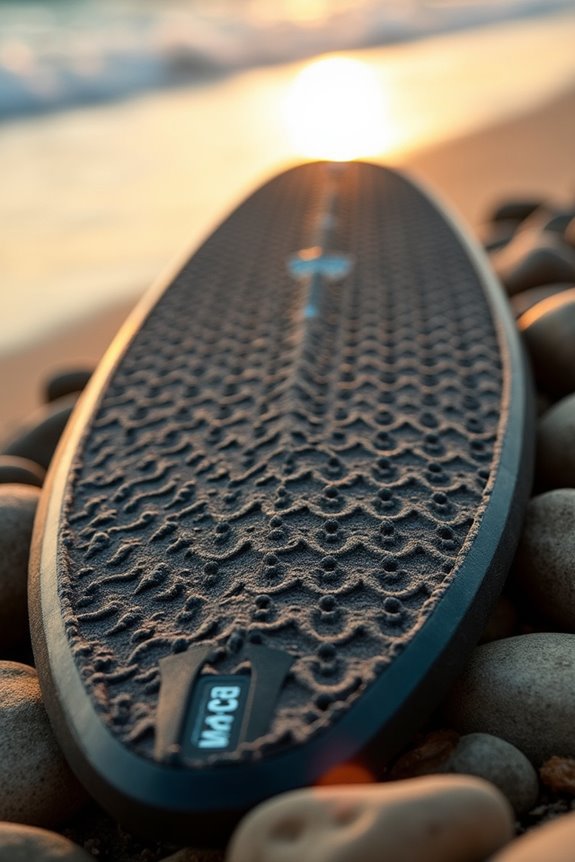
When considering the structure and design components of a traction pad, several key elements contribute to its effectiveness. Traction pad textures play an essential role in grip and control, with diamond-shaped patterns and varying groove depths enhancing durability and performance. Deeper and rougher textures help prevent slipping during maneuvers.
Arch support is another critical feature, as raised arches provide stability by supporting the foot’s natural curve. The height of the arch can vary to accommodate different foot shapes and surfing styles. Additionally, kick features at the rear of the pad prevent the back foot from slipping, balancing grip and comfort. Overall, these design elements work together to improve performance while ensuring rider comfort during extended sessions. Moreover, the choice of materials, such as fiberglass for rigidity, can enhance the overall durability and performance of the traction pad.
Types and Variations
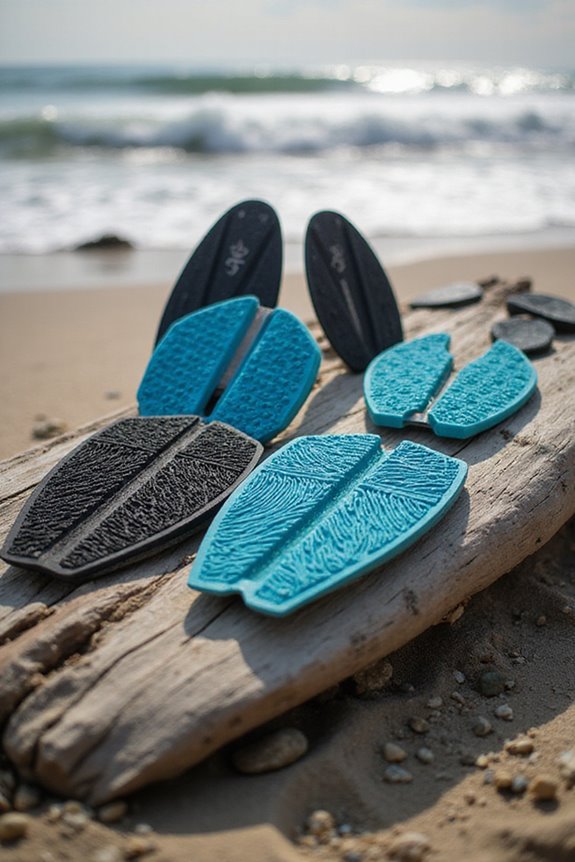
Exploring the various types and variations of traction pads, we can see how they cater to distinct surfing needs and preferences. Traction pads typically come in single piece configurations, offering straightforward installation, but they may not fit every board perfectly. On the other hand, multi piece customization allows for tailored fits, accommodating various board shapes and sizes.
Common configurations include two-piece, three-piece, and even five-piece sets, with three-piece pads being popular for shortboards. Additionally, kick tails, arch bars, and grip patterns vary widely, affecting performance and comfort. By understanding these options, we can choose the right traction pad that aligns with our surfing style and board type. Choosing the right traction pad can also enhance durability and performance, ensuring a better surfing experience.
Benefits and Functional Advantages
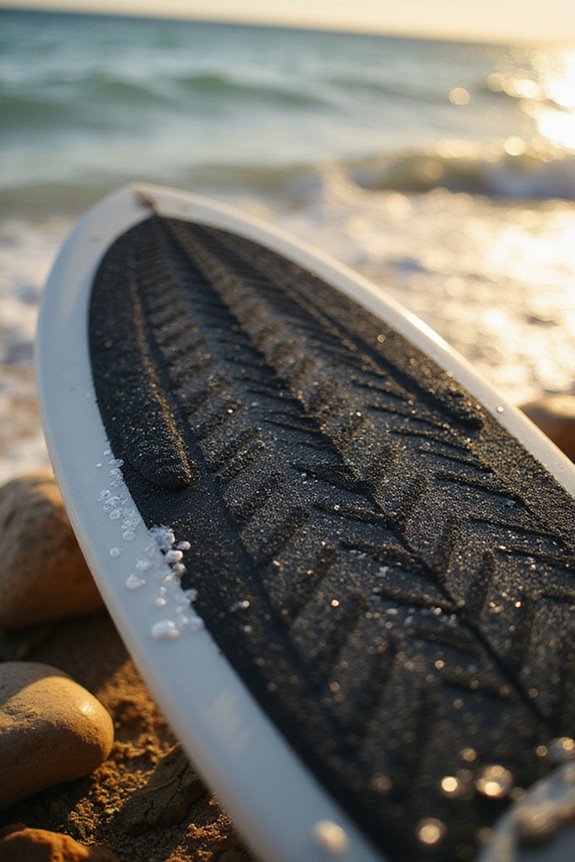
While many surfers may initially overlook the importance of traction pads, these essential accessories offer significant benefits that enhance overall performance and comfort.
Performance Enhancement
Traction pads provide improved grip, allowing for better control during rapid adjustments and powerful turns. They enable advanced maneuvers, ensuring reliable foot stability even in wet conditions. Additionally, soft-top boards often feature traction pads to enhance grip and safety for beginners.
Injury Prevention
Application and Usage Contexts
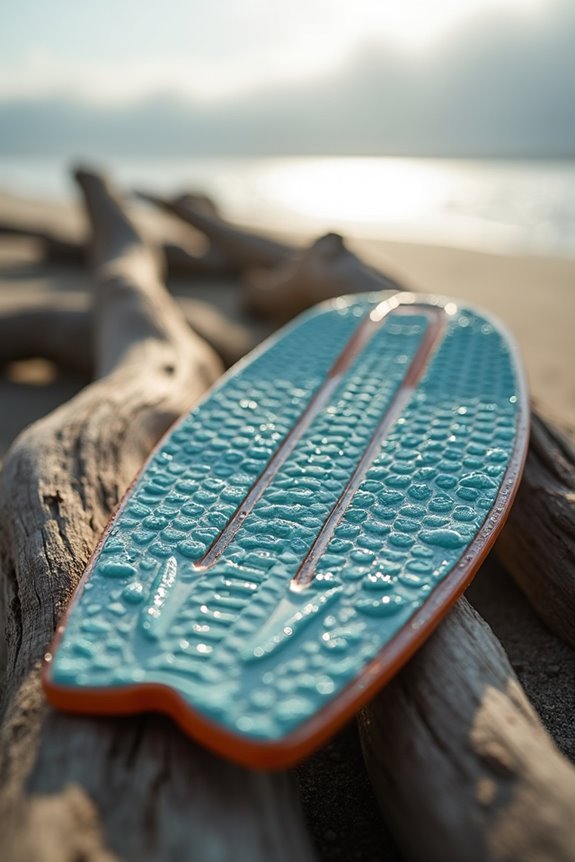
Understanding how to effectively use traction pads can greatly improve our surfing experience. These pads are typically installed at the tail of the surfboard, maximizing surfboard stability and grip enhancement. Proper placement is essential; we should clean the board thoroughly and align the pad about half an inch above the leash plug.
Beginners find traction pads helpful for building confidence and balance, while intermediate and advanced surfers rely on them for aggressive maneuvers like cutbacks and aerials. In challenging conditions, such as big waves, these pads enhance our control. Additionally, traction pads can reduce foot fatigue during long sessions, allowing us to paddle comfortably and wait for waves without discomfort. Maintaining optimal grip on surfboards is crucial for performance, which is why using tools like surfboard fin removal tools can be beneficial for ensuring your equipment stays in top shape.
Selection Criteria
When selecting a traction pad for our surfboards, several key criteria come into play to guarantee we choose the right fit for our needs.
Number of Pieces and Customization****
We can choose from one-piece, two-piece, or multi-piece pads. While single-piece pads offer easy installation, multi-piece designs allow us to customize based on our board’s tail shape.
Arch Support
Considering our foot anatomy is essential. High arch pads provide stability for aggressive surfers, while low arch pads allow more mobility for casual riding.
Kick Feature
The height of the kick affects control. Higher kicks suit performance-driven surfing styles, while lower kicks are better for cruising.
Material and Grip Texture
EVA foam is common, but eco-friendly cork options are available. The surface texture should maximize grip and prevent slipping. Additionally, selecting a traction pad with durability and quality enhances its longevity and effectiveness during use.
Installation Process
Installing a traction pad on our surfboard is a straightforward process that enhances grip and control while riding.
Preparation of Board Surface****
Start by cleaning the board with a damp cloth and letting it dry. Use rubbing alcohol on the tail area for better adhesion, and lightly sand the application area with high-grit sandpaper.
Initial Placement and Alignment
Dry fit the pad for correct placement, centering it with respect to the stringer. Mark edges if needed for precision.
Adhesive Application
Peel back the backing gradually, press firmly to guarantee contact, and stomp down with your weight.
Curing and Final Considerations
Allow 12–24 hours for curing. Common mistakes include not cleaning the surface or applying weight too soon, which can weaken adhesion.
Maintenance and Care Tips
Taking care of our traction pad is essential for ensuring its longevity and performance. We should rinse our surfboard and traction pad with fresh water after each session to eliminate salt, sand, and debris. For cleaning techniques, it’s best to use rubbing alcohol or Windex instead of harsh cleaners that can damage materials.
To protect adhesive types, avoid direct sunlight and heat, storing our boards in cool, shaded areas. Regularly inspecting for dirt accumulation in the grooves helps maintain grip. If we notice any lifting or tears, we should use water-resistant adhesives for repairs. When removing pads, warming them helps soften the adhesive, and we can use plastic scrapers to clear any residue gently.
Frequently Asked Questions
Can Traction Pads Be Reused After Removal?
Yes, traction pads can be reused after removal. Using proper removal techniques and reapplication methods, we can maintain their integrity, but we should be cautious of potential residue and the pad’s overall condition for best performance.
How Do I Clean My Traction Pad?
When it comes to cleaning techniques, we understand that traction pad materials require gentle care. Let’s rinse, use mild soap, scrub softly, and air dry in the shade for best performance and longevity.
Are Traction Pads Suitable for All Board Types?
Are traction pads suitable for all board types? We’ve found that traction pad materials and installation vary, but multi-piece options adapt well to different shapes, ensuring compatibility across various boards for ideal grip and performance.
Do Traction Pads Affect Board Performance?
We’ve noticed that traction pad materials and designs can greatly impact board performance. They enhance grip and stability, allowing for better control, while also affecting the board’s flex and feel during various maneuvers.
How Long Do Traction Pads Typically Last?
Did you know high-quality traction pads can last several years? Their lifespan depends on various durability factors. By following some maintenance tips, like proper installation, we can maximize their longevity and enjoy them longer.

